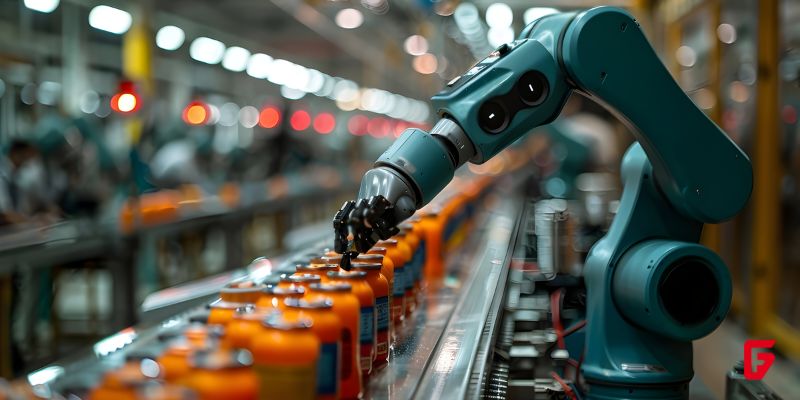By futureTEKnow | Editorial Team
Collaborative robots, or cobots, are transforming modern manufacturing by bridging the gap between human workers and automation. Unlike traditional industrial robots, cobots are designed to work safely alongside people, handling repetitive or physically demanding tasks while allowing employees to focus on more complex and creative work.
This collaboration not only boosts productivity but also reduces errors, improves workplace safety, and lowers operational costs. As manufacturers face increasing demand for efficiency and precision, cobots have become a game-changer, offering a flexible and scalable solution for businesses of all sizes.
Collaborative robots are revolutionizing efficiency and productivity in manufacturing by taking over repetitive and time-consuming tasks that slow down human workers. Cobots can operate around the clock without fatigue, ensuring faster production cycles and consistent output quality.
In assembly lines, cobots can handle tasks like screwing, sorting, or packaging with precision, freeing up employees to focus on more strategic responsibilities. This seamless collaboration between humans and cobots not only speeds up production but also minimizes errors, helping manufacturers meet tight deadlines and maintain high standards of quality.
Implementing collaborative robots in manufacturing can lead to significant cost savings for businesses. By automating repetitive tasks, cobots reduce the need for extensive labor, allowing companies to allocate their workforce to more skilled positions that require human insight and creativity. This shift not only lowers labor costs but also minimizes the risk of errors and rework, which can be expensive in terms of both time and resources.

Cobots are often more affordable to deploy than traditional industrial robots, as they require less infrastructure and can be easily integrated into existing workflows. Overall, the investment in cobots can result in a substantial return on investment, making manufacturing operations more financially sustainable.
These robots are playing a key role in improving quality control in manufacturing. Equipped with advanced sensors and cameras, cobots can perform real-time inspections during production, identifying defects or inconsistencies with incredible precision. Unlike manual inspections, which can be prone to human error, cobots ensure consistent monitoring, catching even the smallest issues before they become costly problems.
In industries like electronics or automotive manufacturing, cobots can measure components with micrometer-level accuracy, ensuring every product meets strict quality standards. By integrating cobots into quality control processes, manufacturers can deliver reliable, high-quality products while reducing waste and rework.
In the assembly process, collaborative robots are proving to be invaluable assets, streamlining operations and enhancing productivity. Cobots can take on repetitive tasks such as fastening, sorting, and placing components with remarkable speed and accuracy. This not only accelerates the assembly line but also allows human workers to focus on more complex tasks that require critical thinking and creativity.
Collaborative robots are transforming machine tending in manufacturing by automating the loading and unloading of materials, which significantly enhances operational efficiency. Cobots can work alongside CNC machines, 3D printers, and other equipment, handling tasks such as placing raw materials into machines and retrieving finished products. This not only reduces downtime but also minimizes the risk of human error during these repetitive processes.
Cobots can easily lift, transport, and organize materials, reducing the physical strain on human workers and minimizing the risk of workplace injuries. For instance, in warehouses and assembly lines, cobots can swiftly move heavy components from one station to another, ensuring that production flows smoothly without delays. Their ability to navigate tight spaces and work alongside humans makes them an ideal solution for optimizing logistics and inventory management.
Quality inspection is a critical area where collaborative robots are making a significant impact in manufacturing. Cobots equipped with advanced vision systems and sensors can conduct thorough inspections in real-time, identifying defects or inconsistencies that might go unnoticed during manual checks. This technology allows for precise measurements and assessments, ensuring that every product meets rigorous quality standards before it leaves the production line.
Collaborative robots are transforming welding processes in manufacturing by delivering unmatched precision and consistency. Cobots can handle tasks like spot welding, arc welding, and soldering with steady accuracy, reducing the risk of errors that can occur with manual welding. Their ability to follow exact specifications ensures stronger, more reliable welds, which is especially critical in industries like automotive and aerospace.
Before implementing collaborative robots, manufacturers must start by assessing their specific needs and objectives. This involves identifying bottlenecks or repetitive tasks in the production process where cobots can add the most value.
If a factory struggles with high error rates in assembly or material handling, cobots can be introduced to improve accuracy and efficiency. It’s also important to consider the goals of the business—whether it’s reducing costs, increasing output, or improving worker safety—and align cobot deployment with these priorities. By clearly understanding where cobots can make the biggest impact, manufacturers can create a focused implementation plan that maximizes return on investment and enhances overall operations.
Launching a pilot project is a smart first step when integrating collaborative robots into manufacturing. A small-scale trial allows manufacturers to test how cobots perform in specific tasks, such as assembly or quality inspection, without disrupting the entire production process. This approach helps identify potential challenges, such as workflow adjustments or training needs, while providing valuable data on the cobot’s efficiency and impact.
For example a manufacturer might deploy a cobot to handle repetitive packaging tasks in one section of the factory to evaluate its productivity and compatibility with human workers. By starting with a pilot project, companies can fine-tune their implementation strategy, build employee confidence, and ensure a smoother transition to full-scale deployment.
Proper training and workforce integration are essential for the successful implementation of collaborative robots in manufacturing. Employees need to understand how to operate, program, and work alongside cobots to ensure a smooth transition. Training should focus on making the technology accessible, emphasizing how cobots can handle repetitive tasks while freeing workers to take on more creative and strategic roles.
Hands-on workshops can teach employees how to program a cobot for tasks like assembly or material handling without requiring advanced technical skills. Additionally, fostering a culture of collaboration between humans and robots helps reduce resistance to change and builds confidence in using new tools. Investing in training is a must, this way manufacturers can create a skilled workforce that maximizes the potential of cobots while improving overall job satisfaction.
Choosing the right technology is a crucial step in successfully integrating collaborative robots into manufacturing processes. Manufacturers should start by evaluating their specific needs, such as the types of tasks the cobots will perform and the environment in which they will operate. Factors like payload capacity, reach, and ease of programming are essential to consider.
A cobot designed for assembly tasks may require different specifications than one intended for welding or material handling. Additionally, it’s important to select a system that can easily integrate with existing machinery and software to streamline operations.
Safety concerns are a top priority when integrating collaborative robots into manufacturing environments. While cobots are designed to work alongside human operators, it’s essential to implement proper safety measures to prevent accidents. This includes conducting thorough risk assessments to identify potential hazards and ensuring that cobots are equipped with safety features such as sensors and emergency stop buttons.
Training employees on safe interaction with cobots is equally important; workers should understand how to operate them safely and recognize their capabilities and limitations.
Integrating collaborative robots with existing systems is a vital step in maximizing their effectiveness in manufacturing. Successful integration involves ensuring that cobots can seamlessly communicate with current machinery, software, and production workflows. This may require evaluating the compatibility of the cobots with existing equipment and making necessary adjustments to facilitate smooth operation.
Manufacturers might need to update software systems or implement new interfaces that allow cobots to share data with other machines on the production line. Additionally, it’s important to involve IT and engineering teams early in the process to address any technical challenges that may arise.

Introducing collaborative robots into manufacturing often requires a cultural shift within the workplace. Employees may initially feel uncertain about working alongside robots, fearing job displacement or struggling to adapt to new technology.
To address these concerns, it’s crucial for manufacturers to foster an open and positive environment where workers understand that cobots are tools designed to assist, not replace, them. Clear communication about the benefits of cobots—such as reducing repetitive tasks and improving workplace safety—can help build trust and acceptance.
Also, involving employees in the implementation process, from training to feedback sessions, empowers them to see cobots as partners rather than competitors.
The integration of collaborative robots in manufacturing represents a significant opportunity for companies to enhance efficiency, reduce costs, and improve product quality. By carefully assessing needs, conducting pilot projects, and investing in employee training, manufacturers can ensure a smooth transition to a more automated environment.
Addressing safety concerns and fostering a culture of collaboration will further strengthen the relationship between human workers and cobots. As technology continues to evolve, embracing these innovations will not only keep manufacturers competitive but also empower their workforce to focus on more strategic and creative tasks.
Founded in 2018, futureTEKnow is a global database dedicated to capturing the world’s most innovative companies utilizing emerging technologies across five key sectors: Artificial Intelligence (AI), immersive technologies (MR, AR, VR), blockchain, robotics, and the space industry. Initially launched as a social media platform to share technology news, futureTEKnow quickly evolved into a comprehensive resource hub, spotlighting the latest advancements and groundbreaking startups shaping the future of tech.

SpaceX aims to nearly double launches from Vandenberg in 2025, facing support from federal agencies but strong objections from the state and local communities.

Traditional Medicare will pilot AI-assisted prior authorization in 2026 across six states, focusing on high-risk outpatient services. Clinicians retain final say, but incentives and access concerns loom as CMS tests fraud reduction and “gold card” exemptions. Here’s what providers and patients should know.

OpenArt’s new “one-click story” compresses scripting, visuals, and edits into ready-to-post short videos—fueling viral growth and a fresh IP debate. We break down how it works, adoption signals, what’s next (multi-character, mobile), and practical guardrails creators and brands should follow to stay original and compliant.

OpenAI’s o3 swept the Kaggle AI chess tournament, defeating xAI’s Grok 4–0. The victory fueled the intense rivalry between Altman and Musk, reshaping AI benchmarks.

NASA and Google’s AI-powered Crew Medical Officer Digital Assistant enables autonomous diagnoses for astronauts on Mars missions, redefining remote healthcare for space and Earth.

Pinterest’s CEO confirms that fully agentic AI shopping is years away, as the platform invests in AI-powered tools to enhance discovery, inspiration, and personalized shopping experiences for millions.

Shopify’s new AI shopping tools are transforming e-commerce, letting agents and chatbots deliver smooth, personalized shopping and checkout experiences across platforms. Learn how these innovations reshape online retail.

Meta has acquired WaveForms AI, a startup pioneering emotion-detecting voice technology. Learn what this means for Meta’s AI voice ambitions and the future of AI audio.

Tracelight is revolutionizing financial modelling for finance professionals with AI-powered Excel tools that automate complex tasks, reduce errors, and unlock new analysis capabilities. Learn how this next-gen solution changes the future of spreadsheets.

China’s Lanyue lander completed its first major test, showcasing advanced engineering for safe, crewed moon landings before 2030. Explore how this milestone shapes the space race.

Microsoft rolls out GPT-5 across its Copilot suite, integrating smarter AI for enterprise and personal users. Discover new features, free access, and what sets this launch apart.

OpenAI’s GPT-5 is now live for all ChatGPT users. It brings faster, smarter AI with improved reasoning, expanded context, and safer outputs—marking a major leap in generative technology.
To provide the best experiences, we use technologies like cookies to store and/or access device information. Consenting to these technologies will allow us to process data such as browsing behavior or unique IDs on this site. Thanks for visiting futureTEKnow.